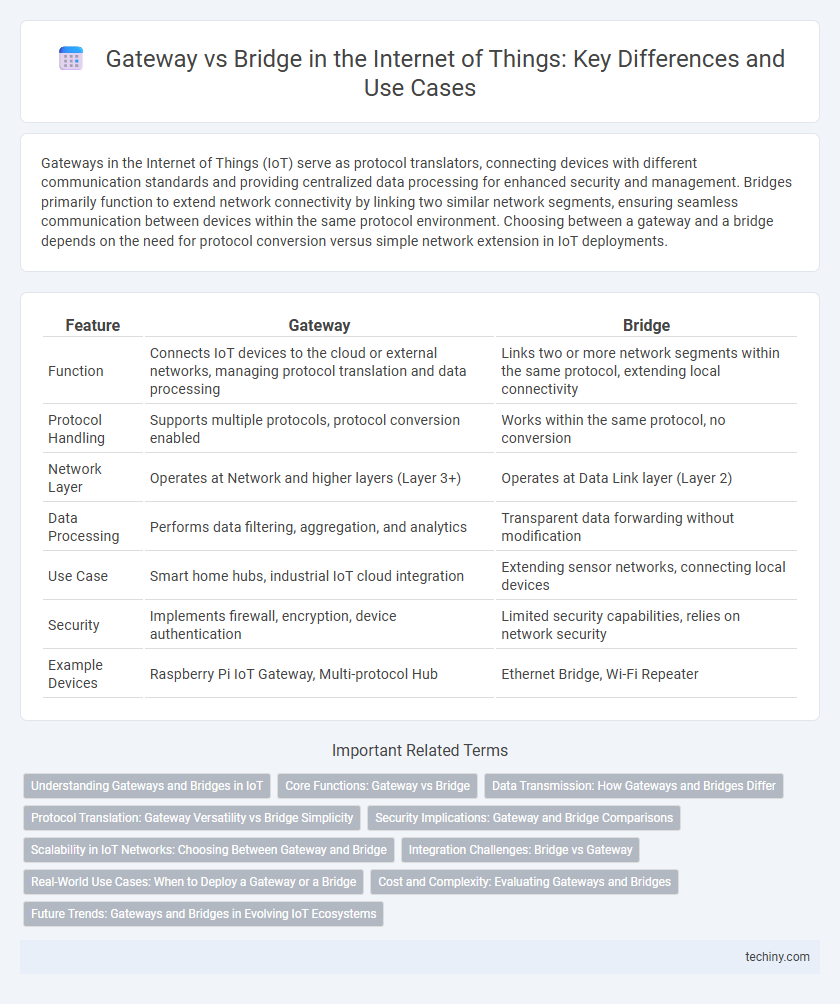Gateways in the Internet of Things (IoT) serve as protocol translators, connecting devices with different communication standards and providing centralized data processing for enhanced security and management. Bridges primarily function to extend network connectivity by linking two similar network segments, ensuring seamless communication between devices within the same protocol environment. Choosing between a gateway and a bridge depends on the need for protocol conversion versus simple network extension in IoT deployments.
Table of Comparison
| Feature | Gateway | Bridge |
|---|---|---|
| Function | Connects IoT devices to the cloud or external networks, managing protocol translation and data processing | Links two or more network segments within the same protocol, extending local connectivity |
| Protocol Handling | Supports multiple protocols, protocol conversion enabled | Works within the same protocol, no conversion |
| Network Layer | Operates at Network and higher layers (Layer 3+) | Operates at Data Link layer (Layer 2) |
| Data Processing | Performs data filtering, aggregation, and analytics | Transparent data forwarding without modification |
| Use Case | Smart home hubs, industrial IoT cloud integration | Extending sensor networks, connecting local devices |
| Security | Implements firewall, encryption, device authentication | Limited security capabilities, relies on network security |
| Example Devices | Raspberry Pi IoT Gateway, Multi-protocol Hub | Ethernet Bridge, Wi-Fi Repeater |
Understanding Gateways and Bridges in IoT
Gateways in IoT serve as critical nodes that connect IoT devices to the cloud, enabling data processing, protocol translation, and security enforcement at the edge. Bridges function primarily to link different network segments within local IoT environments, facilitating communication between devices on disparate networks without extensive data manipulation. Understanding the distinct roles of gateways and bridges helps optimize network architecture for efficient data flow, lower latency, and enhanced device interoperability in IoT systems.
Core Functions: Gateway vs Bridge
Gateways in the Internet of Things (IoT) primarily perform protocol translation, data filtering, and device management, enabling communication between IoT devices and external networks or cloud platforms. Bridges focus on connecting similar network segments at the data link layer, facilitating communication within the same protocol family without altering data formats. While gateways handle complex data processing and security functions, bridges mainly extend network connectivity and maintain seamless communication within local IoT environments.
Data Transmission: How Gateways and Bridges Differ
Gateways in Internet of Things (IoT) systems perform protocol translation and data processing, enabling communication between different network types and managing data traffic efficiently. Bridges primarily operate at the data link layer, facilitating direct data transmission within the same network protocol without altering the data format. This distinction impacts data transmission by allowing gateways to handle complex, cross-network communication, while bridges maintain local network connectivity with minimal latency.
Protocol Translation: Gateway Versatility vs Bridge Simplicity
IoT gateways provide versatile protocol translation capabilities, enabling seamless communication among diverse devices and networks by converting various protocols such as MQTT, CoAP, and Zigbee. Bridges offer simpler protocol handling, typically connecting two similar or compatible networks without extensive translation. This makes gateways essential for complex IoT deployments requiring multiple protocol interoperability, while bridges suit straightforward, localized network extensions.
Security Implications: Gateway and Bridge Comparisons
Gateways in IoT provide robust security by performing protocol translation and enforcing access controls, isolating local networks from external threats. Bridges connect similar networks at the data link layer, offering limited security features and potentially exposing devices to unauthorized access. Implementing gateways enhances network segmentation and intrusion detection, improving overall IoT security posture compared to bridges.
Scalability in IoT Networks: Choosing Between Gateway and Bridge
Gateways offer superior scalability in IoT networks by managing diverse protocols and aggregating data from multiple devices, enabling seamless integration and centralized control. Bridges function primarily to extend network range by connecting similar network segments, which limits their ability to handle extensive device heterogeneity and high data volumes. Large scale IoT deployments benefit from gateways due to their enhanced processing capabilities and support for complex network architectures.
Integration Challenges: Bridge vs Gateway
Integration challenges in IoT arise as gateways and bridges serve distinct roles in connecting devices with networks. Gateways perform protocol translation and data processing, enabling communication between heterogeneous IoT devices and cloud platforms, often requiring complex configuration and scalability considerations. Bridges primarily extend network coverage by linking similar network types, facing fewer protocol integration issues but limited in managing diverse IoT protocols compared to gateways.
Real-World Use Cases: When to Deploy a Gateway or a Bridge
Gateways are ideal for complex IoT ecosystems requiring protocol translation, data filtering, and edge computing, such as smart cities managing diverse sensor networks and analytics. Bridges suit simpler, localized networks needing device interconnection without protocol conversion, like connecting Zigbee devices to a Wi-Fi network in smart homes. Deploy gateways in scenarios demanding advanced security and data processing at the edge, while bridges streamline communication within homogeneous device groups.
Cost and Complexity: Evaluating Gateways and Bridges
Gateways typically incur higher costs and complexity due to their advanced processing capabilities and protocol translation functions, essential for integrating diverse IoT devices into a unified network. Bridges offer a more cost-effective and simpler solution by connecting similar network segments, but lack the extensive data handling and security features of gateways. Evaluating IoT infrastructure investments requires balancing the higher upfront expenses and operational demands of gateways against the streamlined, lower-cost implementation of bridges.
Future Trends: Gateways and Bridges in Evolving IoT Ecosystems
Gateways are evolving to support edge computing and AI integration, enabling real-time data processing and enhanced security within IoT ecosystems. Bridges continue to facilitate seamless protocol translation and device connectivity, crucial for interoperability in heterogeneous networks. Emerging trends highlight a convergence where gateways incorporate bridging functionalities, optimizing data flow and scalability in future smart environments.
Gateway vs Bridge Infographic

 techiny.com
techiny.com